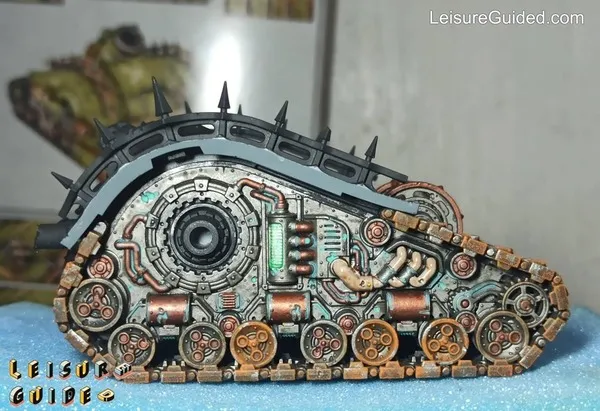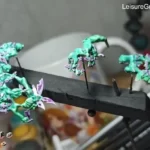Miniatures’ Varnish: Matte vs Satin vs Gloss (Varnish Guide)

A varnish is important for no other reason than to seal the paint and prevent it from chipping off. Chipped paint is common with metal minis, but it can also happen with resin and plastic miniatures.
We did some research to see how they work. From our results, they each give different types of effects. Gloss varnish is shiny and works effectively for blood effects, oozy gunk, and reflective faceplates.
Matte varnish is dull and retains high color contrast on miniatures.
Satin varnish is the middle ground between gloss and matte, which is a very flat finish.
But, that’s not all!
Matte vs. satin vs. gloss varnish For miniatures pros & cons
Matte, gloss, and satin varnishes are mostly used to seal paint jobs on miniatures. While they may also provide the same sealing abilities, their texture and finish differ.
1. Matte varnish pros & cons
Matte varnish is one of my favorites simply because it retains a great luster that I enjoy without too much distracting shine on my miniature.
However, it is more prone to clouding and misting, making the finished work spot a displeasing white snot-like effect. This mostly happens when you varnish excessively thick layers or if you varnish the figure before the paint is completely dry.
Matte varnish Pros
- It is very hard wearing
- Retains details easily
- It makes details pop without much shine
- Easy to use
- Works well for brush-on and spray application
Matte varnish Cons
- It may appear cloudy
2. Satin varnish pros & cons
Satin is similar to a matte varnish with only a subtle difference – it’s level of sheen.
Satin varnishes will have a slight shine so that it doesn’t look so dull but more flat gloss. For one, I always use a satin varnish on my smaller tabletop minis so that they look nice at all times and don’t collect dust.
Satin varnish Pros
- Works well with spray application
- It offers a moderate gloss finish
- It hides imperfections in the paint well
- Easy to clean
Satin varnish Cons
- It is usually more expensive than matte varnish
3. Gloss varnish pros & cons
Gloss coats are also one of my favorites because they are significantly more resilient to chipping.
The only drawback to using gloss varnish is that your figures may look too shiny and chrome. Furthermore, gloss varnish dries the hardest thanks to its thick pigments.
Gloss varnish Pros
- More durable and long-lasting finish
- It does not chip easily
- Easy to clean
- It offers smoother results than matte and satin varnishes
Gloss varnish Cons
- Slow dry time
- It highlights imperfections in miniatures
Matte varnish will keep true colors the best
If you have read our post on “Do you need to Varnish Miniatures,” you will know that varnishing the miniature can make the color look different.
Applying a gloss varnish on red colors used for blood will make the red look overly shiny, wet, and slimy as it rained on the paint. This shiny appearance of the red paint makes the paint look unnatural and more like a brilliant orange-red vermillion.
Satin and matte also steal the color a bit off the paint, reducing its quality.
But unlike satin and a very flat finish, matte makes the paint look more natural.
Matte vs. satin vs. gloss varnish, I use matte on everything except metallic colors
They will all look good on your miniature’s surface.
However, my personal preference is matte on everything except metallic colors.
Satin works better on metal, as it makes black-armored characters look more sinister. Gloss on metal makes the figure look too wet than shiny. Gloss will look better on gemstones and glass. It will also help with painting drool and blood.
Matte, satin, and gloss varnish will all protect the paint of your miniature
Varnishing protects the miniature’s paint job from being damaged due to use or transportation. Varnishing alone isn’t usually enough. But, there’s a catch.
Varnishing alone won’t do the job of safeguarding the paint from chipping or damage. Proper priming and letting the paint cure fully are important.
Is ‘gloss tougher than matte’ a myth?
No, gloss and matte varnish offer the same strength advantage when it involves protecting the paintwork from damage. But, this applies to plastic figures.
On metal miniatures, a gloss varnish may be tougher and more durable.
When used on figures, the paint does not absorb the gloss varnish but sticks well, making it easy to create uniform surface coats that are very smooth.
On the other hand, the matte varnish is surface-absorbent. So, sometimes the matte and polymer agents become separated, making the paint appear not so smooth and break easily.
The non-absorbent nature of gloss varnish makes them dry hard and turn into a thick wall that makes the paint last longer.
Most mini painters will use matte or satin rather than gloss
A good varnish will give your miniatures a clean and long-lasting finish.
It’s no wonder many experienced painters will opt for matte or satin varnish because they even out all the reflections on a shiny surface and save details, unlike gloss varnish which hides details due to its high shine.
Matte, gloss, and satin are great sealants for metal and plastic minis. When applied properly, the matte varnish will look smooth and keep your color contrast high while maintaining all your hard work painting the model.
Satin looks like matte sealant but with a slight gloss sheen. This does not mean that they are glossy, but the miniature figures will have a light reflective quality.
On the other hand, gloss adds an extra reflective layer of sheen and may reduce the amount of detail and color that shows through the final coating so that the detailed parts have little to no clarity underneath the paint job. The fact that they hide details alone makes painters more attracted to matte and satin varnishes.
how to properly apply varnish on your miniature, whether its gloss, matte, or satin
Whether you prefer varnishing from a spray can, airbrush varnish, or with a paintbrush, matte, satin, and gloss varnish allows for spray and brush-on application.
Just wear a respiratory mask when spraying varnish on miniatures to avoid health and safety risks.
*I always varnish with 1 coat of gloss and then 1 coat of matte
A typical way to apply varnish will be 1 coat of gloss and 1 coat of matte.
This method gives extra coverage on the details without hiding anything.
You can use gloss for your first coat, then spray or brush it down with matte varnish. The miniature surface will look smoother with the gloss, and the matte will restore the original color.
For the best results, you should use all 3 types of varnish
Mixing gloss and matte after the other in single layers is a good way to apply them to your small figures. But a far better approach that offers the best varnish results is to use both on different parts of the figure.
Matte or satin will work great for textured surfaces such as skin and fabric, while gloss will serve well on glossy surfaces such as weapons, metals, gems, and water.
Conclusion
Most painted minis tend to come out patchy and with fingerprints. Varnishing your small figures is a good way to protect the miniature and give it a more consistent finish. If you want a little shine on your weapons, blood, or water, use a glossy varnish. Matte will offer smoother and more natural yet dull results, while satin adds the glossy and muted feature of matte, so your figures have a medium reflective pop.
Sources
https://blog.vexillia.me.uk/2009/02/painting-tips-4-gloss-vs-matt-varnishes.html




